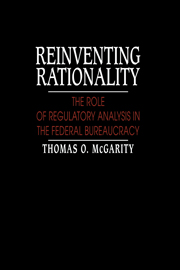Book contents
- Frontmatter
- Contents
- Acknowledgments
- Abbreviations
- Introduction
- Part I The clash of regulatory cultures
- Part II Regulatory analysis in theory and practice
- 3 Getting the lead out of gasoline: EPA's lead phasedown regulations
- 4 Getting the dust out of the air: EPA's ambient air quality standard for particulate matter
- 5 Getting obstructions out of the driver's view: NHTSA's field of direct view regulations
- 6 Getting the bone out of processed meat: FSIS's mechanically separated meat standard
- 7 Getting information into hazardous workplaces: OSHA's hazard identification regulations
- 8 The virtues of regulatory analysis
- 9 Limitations of regulatory analysis
- 10 Regulatory analysis in the real world
- Part III Structuring regulatory analysis into the decisionmaking process
- Part IV Review of regulatory analysis
- Part V Conclusions
- Notes
- Bibliography
- Index
8 - The virtues of regulatory analysis
Published online by Cambridge University Press: 16 October 2009
- Frontmatter
- Contents
- Acknowledgments
- Abbreviations
- Introduction
- Part I The clash of regulatory cultures
- Part II Regulatory analysis in theory and practice
- 3 Getting the lead out of gasoline: EPA's lead phasedown regulations
- 4 Getting the dust out of the air: EPA's ambient air quality standard for particulate matter
- 5 Getting obstructions out of the driver's view: NHTSA's field of direct view regulations
- 6 Getting the bone out of processed meat: FSIS's mechanically separated meat standard
- 7 Getting information into hazardous workplaces: OSHA's hazard identification regulations
- 8 The virtues of regulatory analysis
- 9 Limitations of regulatory analysis
- 10 Regulatory analysis in the real world
- Part III Structuring regulatory analysis into the decisionmaking process
- Part IV Review of regulatory analysis
- Part V Conclusions
- Notes
- Bibliography
- Index
Summary
The three regulatory reform themes described in Chapter 1 – rational decisionmaking, bureaucratic accountability, and regulatory relief – merged in the mandates of Executive Order 12,291 and the Regulatory Flexibility Act that agencies analyze the impacts of their regulations on the regulated entities. Many regulatory reformers believe that regulatory analysis will inspire agencies to promulgate more logical (and less burdensome) rules in a way that ensures accountability to the President, the Congress and the public. These are high expectations indeed for a conceptual framework, but to some extent they are warranted. Comprehensive analytical rationality has many virtues, and it has great potential for enhancing the quality of regulatory decisionmaking. This chapter will first examine the concept of regulatory analysis and attempt to place it in the context of a larger body of experience and thought devoted to the broader practice of policy analysis. Next, the chapter will discuss the virtues of analysis and suggest how regulatory analysis can advance the goals of rational decisionmaking, bureaucratic accountability, and regulatory relief. We will save for Chapter 9 the discussion of the impediments to using regulatory analysis and the inherent limitations in the conceptual framework that make it less useful and desirable in real-world decisionmaking contexts.
Essential aspects of regulatory analysis
The enormous expansion of government since World War II has precipitated many ambitious attempts to manage governmental decisionmaking. The success of quantitative techniques to manage the war effort made students and practitioners of government optimistic that similar techniques could aid policymakers in other large bureaucratic contexts.
- Type
- Chapter
- Information
- Reinventing RationalityThe Role of Regulatory Analysis in the Federal Bureaucracy, pp. 111 - 123Publisher: Cambridge University PressPrint publication year: 1991



